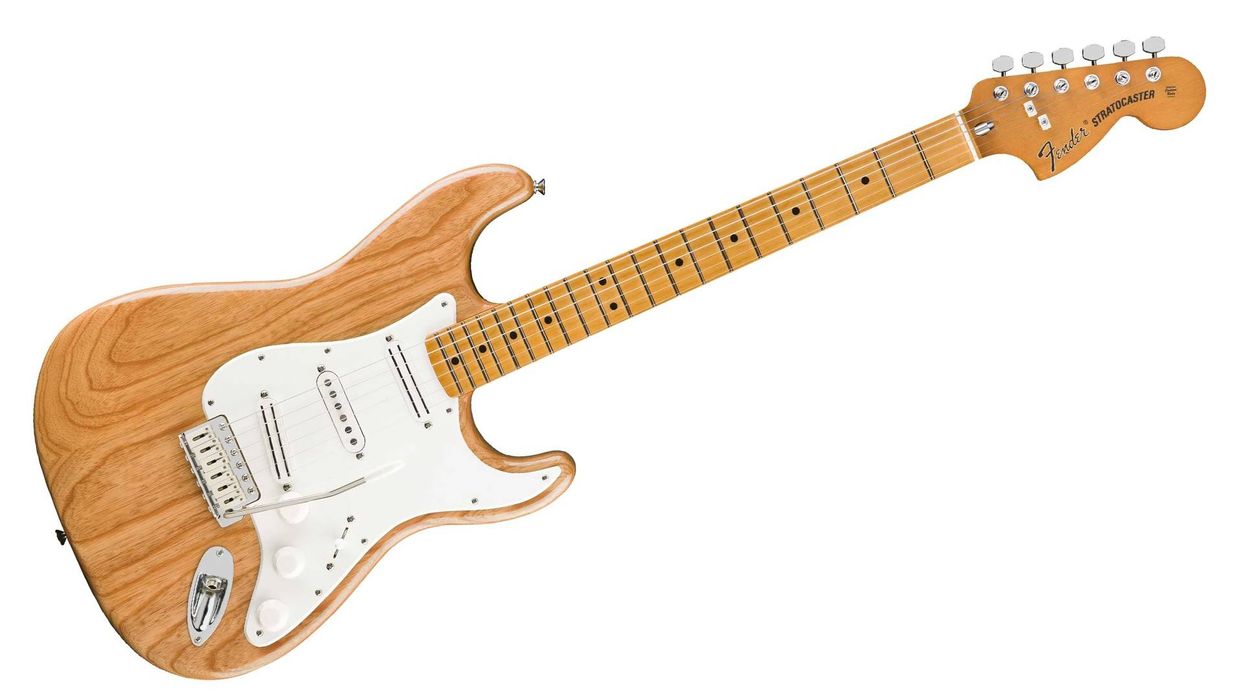In May 2007, a 92-year-old Les Paul returned to his birthplace, Waukesha, Wisconsin, to put on a concert. Local fans and members of the media lined the gate at the airport, waiting to get a glimpse of their hometown hero.
Amid the screaming crowd, the television cameras, and the reporters with microphones at the ready, a young man with obvious physical challenges sat in an electric wheelchair. As Paul walked through the crowd, he held up his hand for the media to halt. He walked toward the young man in the wheelchair, then leaned over and whispered in his ear. The young man’s eyes grew wide, a smile spread across his face, and his body began to shake with joy as Paul gently rubbed his back. After a few minutes, Paul stood up, stepped back, and motioned that he was now ready to address the rest of the crowd.
“It was as though Les had been an angel who had come down and inspired that young man,” says Sue Baker, program director for the Les Paul Foundation. Baker was the executive director of the Waukesha County Museum at that time, and present at the airport scene. She witnessed Paul’s effect on people many times over the years. “I loved spending time with him,” she says fondly. “If you knew Les Paul, you just had to love him and be inspired by him.”
This is a story about Les Paul, the man. The creative force with an innovative mind who always had a plan for action.
And so, it’s fitting that the first thing a visitor encounters upon entering the Les Paul Big Sound Experience—a 53-foot interactive mobile tour that’s been traveling the country for the 100th anniversary of Les Paul’s birth—is a video of Paul himself, where he intimately describes his main pursuit in life.
Visitors are greeted with this short video of Les Paul explaining his passion for sound.
“I want sounds that have never been heard on Earth,” he says. “I want new sounds. And to create those sounds is terribly important. Sound has been the most important part of my life, in music.”
This little window into the soul is a fitting kickoff for a tour through the life of one of the great musical minds and inventors of the 20th century. Les Paul would have been 100 years old on June 9, 2015. Those at the Les Paul Foundation knew they wanted to do something big to celebrate this benchmark.
“This man deserves recognition that he just doesn’t have,” says Jeff Salmon, a trustee of the Les Paul Foundation who came to know Paul by seeing him play hundreds of times in New York City. “We decided the best way to do that is to take Les to the people.”
And thus the Les Paul Big Sound Experience was conceived to honor the guitar godfather’s legacy by showing slices of history from his personal life. Most guitar aficionados know about the man who helped develop Gibson’s first solidbody guitar, but there are some out there who think “Les Paul” is literally just a guitar model.
From the opening 45-second snippet of Les Paul talking about sound, to listening stations with hit records of him playing those sounds, to audio samples of the guitars he invented, to all of the many interactive kiosks and storytelling aspects of the tour, visitors learn how a radio-obsessed little kid went from a small town in Wisconsin to playing the Iridium in New York City every Monday night, and how he forever changed the way popular music is recorded.
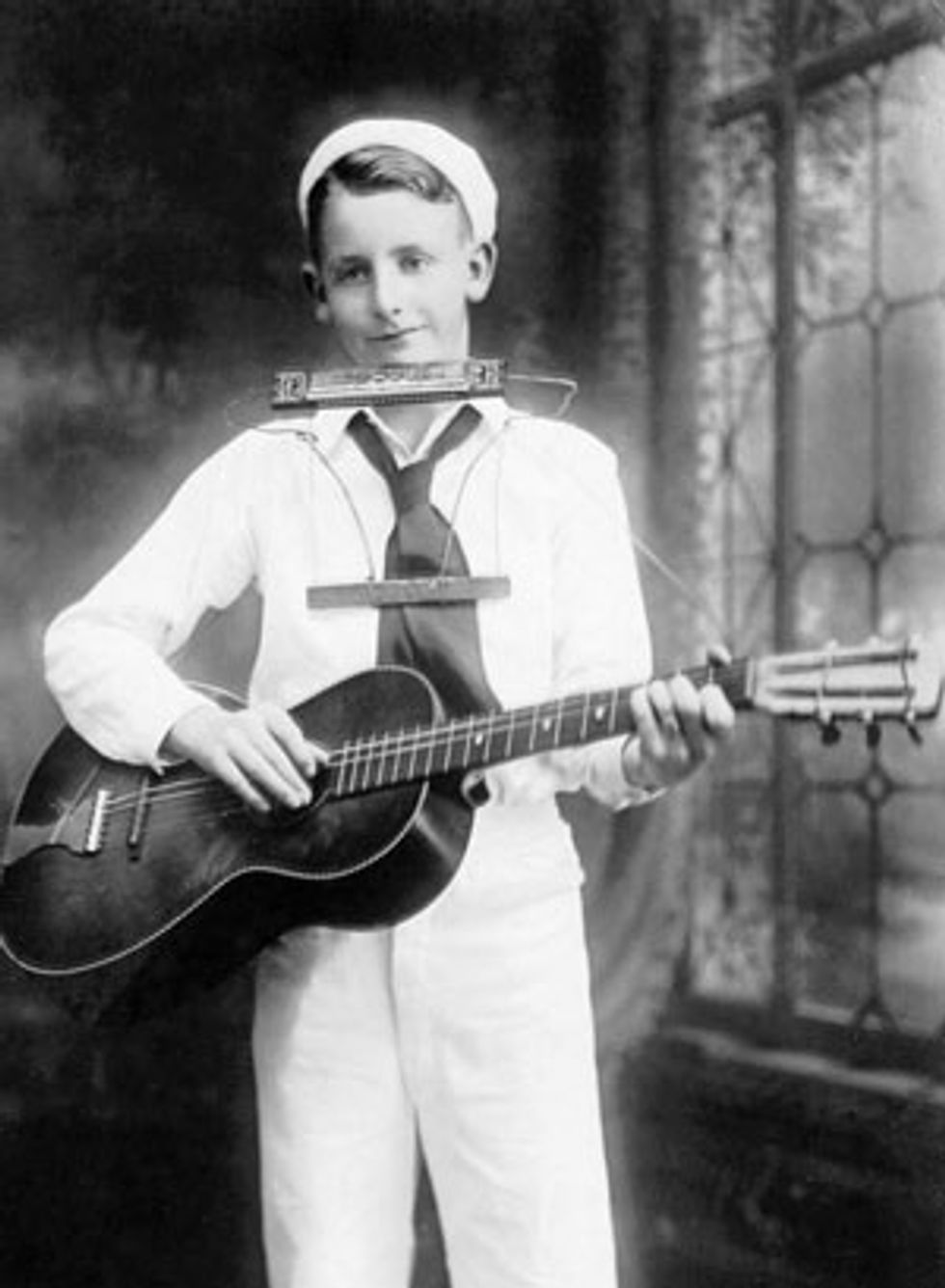
At age 8, Les Paul invented a homemade harmonica rack using household items such as a wire hanger. The rack allowed him to play both sides of the harmonica without putting his guitar down.
A Curious Kid
The Big Sound Experience has a “layered” floor plan, meaning that visitors can choose what they want to explore: There is no chronological order and each portion of the exhibit can stand on its own. For example, you can get your picture taken with Les Paul and have it emailed to yourself. You can make your own multitrack mix by adding or subtracting instruments and effects into Les Paul’s “Brazil.” You can learn about the evolution of guitars that led to the Les Paul model.
But perhaps the most impressive part of the Experience lies in discovering the many dimensions of Les Paul’s life, from his professional and historical milestones, to his larger-than-life personality and resolute spirit.
As the story goes, at age 8, Les Paul began playing harmonica and invented a type of rack that would allow him to play both sides of his instrument without putting his guitar down to readjust. He bought his first guitar—a Sears and Roebuck Troubadour—at age 11 for less than $5. By 1928, at age 13, he was performing with his own stage name: Red Hot Red.
“I’ve loved the guitar ever since Pie Plant Pete let me hold his,” reads a quote from Les Paul in the Experience tour. “I went to sleep thinking about them, woke up thinking about them, and dreamed about what I was going to do with them in between.”
It’s well documented that he was obsessed with guitars from an early age. But another obsession surfaces in the Big Sound Experience journey, and it starts with a kid thirsting for knowledge and wanting to know how everything works. In the early 20th century, radio was the medium people used to follow what was happening around the world and Paul wanted to know all about it. He became particularly entranced after performing at regional radio stations, where his access let him learn about the radio process from station engineers.
For three decades Lou Pallo played rhythm guitar for Les Paul and was the longest-running musician to accompany the pioneering inventor. The pair is shown here performing in their natural habitat: the Iridium in New York City.
Photo by Chris Lentz/Les Paul Foundation
Three Les Paul quotes displayed in the Big Sound Experience are particularly telling about his relationship to radio:
“I’m curious about how all this works. Someone sings into a microphone somewhere, and from there, where does it go and how does it get into my head?”
“After I had that little crystal set and discovered the best reception was late at night, I’d use the springs in my bed for an antenna and stay up all hours listening to whatever I could find … I didn’t care if I got any sleep or not.”
“It’s hard for someone now to understand what a powerful thing radio was then. Our radio was the most important thing in the house, the most awesome device. It was like the internet today because it connected you with things that were going on all over the country.”
And of course, the incarnations of Paul’s earlier guitar experimentations are documented with quotes about what he was trying to do, and what he discovered along the way. In the 1930s, he began with “the Rail,” and then his next creation surfaced in 1941, at age 26. It was at this time that he first approached Gibson with his solidbody electric nicknamed “the Log.”
“Despite its sweet tone and lack of feedback, Gibson turned it down, calling it a ‘broomstick with pickups on it,’” reads the literature in the Experience. The saga continued for the next decade.
In the early 1940s he worked with “the Klunker,” a modified 1942 Epiphone Broadway. After that he soon acquired two more guitars from Epiphone that had “trap doors” he could experiment with. He called these “Klunker Two” and “Klunker Three.”
As most guitar buffs know, it was during this time that Paul’s friend, Leo Fender, developed his version of the solidbody guitar and gave Les a prototype. Les took the Fender Telecaster prototype to Gibson, along with the Log and a very clear message that it was now or never. Gibson finally listened, and the Les Paul model began its development.
Les Paul’s famous guitar has transcended time, and to this day, guitarists hail the 1952 Les Paul as the holy grail of solidbody design. But for the intrepid inventor, this was a long time coming: It actually took a decade before Gibson finally accepted Paul’s solidbody concepts.
“Les had so many things in his life that took him a decade to achieve,” says Baker. “It took 10 years from the time he was a kid living in Waukesha and took that two-foot piece of rail and put the guitar string over it. That was the first solidbody guitar but it was another 10 years before he made the Log, and then another 10 years before the Les Paul solidbody guitar was created.
“My thought is, everybody’s got a challenge in life that could take all sorts of forms, but when a person looks at someone as iconic as Les Paul and understands it took him 10 years to achieve that, it helps a person go, ‘Okay, maybe I need to be just a little more patient.’”
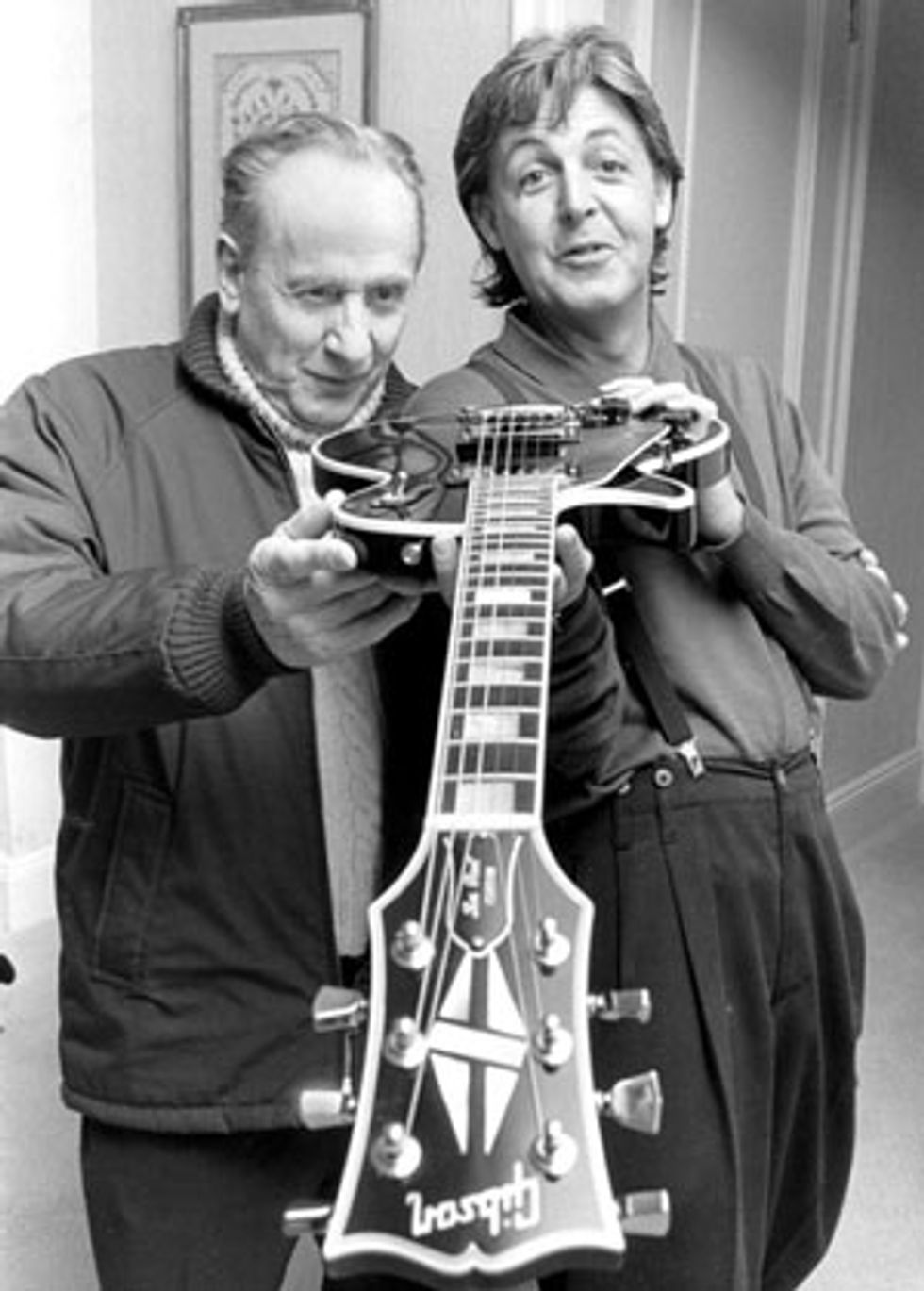
The Pauls stare down a Les Paul Custom.
In the Face of Adversity
Les Paul’s life was riddled with many triumphs, but also many tragedies and health ailments. When he was 32, he and wife Mary Ford were driving when their car skidded off an icy bridge and slid down a ravine. Ford was fairly unscathed, but Paul wasn’t quite as lucky. His broken bones and injuries were so severe that one doctor advised amputation of his shattered right arm. Not wanting to end his career as a guitarist, Paul got a new doctor and opted for surgery. Paul’s own thoughts on the matter are quoted in the exhibit: “The doctors said there was potential nerve damage, that I shouldn’t count on regaining full use of the hand, but I wasn’t buying it,” he said. “I was determined it was going to come back and that I would play again.” Of course, he was right.
Baker points to this persistence, this aptitude to overcome, as one of Les Paul’s most admirable lifelong philosophies, and something that helped him achieve so much. “He was always problem-solving, like ‘Okay, here’s a challenge,’ she says. “I remember early on when I knew him and he was telling me in-depth about that car accident in ’48. He’s talking about all the broken bones and he just casually goes: ‘And I was the luckiest person in the world.’ And then he changed the subject and started talking about something else.
“I said whoaaaa. Stop, stop, stop—you have to back up. There is no one else in the world who would tell me they went through something as horrific as that car accident and end it by saying you’re the luckiest person in the world. You have to explain this to me.
“And Les said, ‘Sue, it’s obvious. I was living my life too fast and I wasn’t going to stop. The car accident made me stop and gave me a chance to evaluate where I had been, and where I wanted to go.’ That’s how he looked at life over and over again. Situations where most of us would melt into a little pity party—Les didn’t do that. He said, ‘I’ve got this situation and here’s an opportunity to learn something new.’”
In 2009, Popular Science Magazine called Les Paul “popular music’s Thomas Edison.” He is the only person to be included in both the Rock and Roll Hall of Fame and the National Inventors Hall of Fame.
Paul invented much more than the Log. He also invented multitracking, close miking, and various echo and tape delay methods. He invented things big and small throughout his entire life, as a result of necessity and function, and sometimes even in the face of his own failing health, he showed extraordinary spirit by confronting it head on.
The Les Paul Foundation’s mission is to inspire innovative and creative thinking by sharing the legacy of Les Paul.
Later in life he suffered hearing problems and had to wear hearing aids, but he didn’t think the ones on the market were good enough. So he started tinkering and eventually invented his own hearing aids. This is a common thread of Paul’s life, even down to bespoking his own guitar picks as he aged.
“Because his fingers were frozen [from arthritis], it was hard for him to hold a standard guitar pick,” says Baker. “But he started creating his own picks and he made them about a quarter of an inch thick and then put sandpaper on both sides so it would be easier for him to hang on to.” Paul developed arthritis in his 40s that affected his mobility for the rest of his life, yet he continued to play guitar until his death in 2009 at the age of 94.
“He went from being a curious kid to a very curious older gentleman,” Salmon adds. “He never changed.”
High Fidelity
As one goes through the Les Paul’s Big Sound Experience, even the astute guitarists will likely find some remarkable Les Paul-ism that makes them stop and consider the brilliance of his inventive mind. “It’s so amazing,” Salmon says. “You can think of things that apply from what Les invented, and see how they’re the foundation of today’s digital technology.”
Lou Pallo, Les Paul’s rhythm guitarist for 30 years, was deeply impacted by his musical colleague. Pallo and Paul were very close, and traded a lot of tricks along the way. “When I was in high school, Les Paul and Mary Ford were the biggest thing,” Pallo recalls. “Since I was playing guitar, he was one of my heroes. Les had high-fidelity before it was even born. When you played ‘How High the Moon’ on the jukebox in those days, and then put on another hit record, it just didn’t sound as ‘live’ as Les did. He just had a great sound—it was unbelievable. That’s why they call this the ‘sound experience.’”
Pallo traces this quest for sound all the way back to when Paul would experiment with his mother’s piano rolls. “Before the electric piano, they pumped the piano. If you pumped fast, the song would go fast, or pump slow and it’d go slower,” Pallo says. “It would never change key. Today that is called digital. But when you would speed up a record, you’d sound like the Chipmunks. And if you slowed it down you’d sound like, rawwr rawwwwr. Les Paul was a genius, let me put it that way. He didn’t invent that, but he knew that in those days by figuring out the piano roll.”
As a traveling musician, Paul found inventive ways to record sounds on the road. “He’d hear the echo in a bathroom, so he’d put a speaker at one end of the bathroom, and then on the other end he’d have a microphone, which would pick up that echo sound,” Pallo says.
It didn’t stop there, of course. Later Paul built his own echo chambers at his home in Mahwah, New Jersey. And in the 1950s, he designed echo chambers in the lower level of Hollywood’s Capitol Records that are still used today. The subterranean concrete bunkers extend 30 feet under the Capitol parking lot and provide reverberation that’s controlled at the sound mixing board. Sound is sent from the studios to speakers in the echo chambers, and picked up by microphones.
An interactive multitracking station lets guests make emailable mixes.
“Whoever is recording in Studio A and Studio B at Capital Records is using that echo,” says Salmon. “A cement block Les built is still being used today—no change, no improvement, nothing else had to be done. Echo is echo and sound is sound and room acoustics are still room acoustics. And what he did back then still applies 50 or 60 years later. That blows my mind.”
Speaking of out-of-this-world impact, it turns out Les Paul’s work ended up reaching as far as the National Aeronautics and Space Administration, aka NASA.
Baker learned from Karl F. Anderson, a retired Measurement Systems Engineer at NASA, that Les Paul’s multitracking inventions and research were vital to space experts. “He said that we were at a point in the ’50s where we had so much data, that we were at a stalemate because we couldn’t manage all of this information in order to move the space program forward,” Baker says.
When Paul came up with “sound on sound,” researchers at NASA looked at that and thought if sound can be layered, they should be able to layer data in a similar way. And eventually they were able to adapt Paul’s multitracking techniques to accomplish this.
“That’s what moved the space program forward,” Baker says. “So Les impacted the U.S. Space Program. Go figure!”
Four guitar designs Paul developed are virtually explained with audio examples.
Can You Guess Les Paul’s Signature Lick?
In the guitar history portion of Les Paul’s Big Sound Experience, there is recorded audio of each incarnation of Les Paul’s guitar design evolution: The Rail, the Log, the Klunker, and the 1952 Les Paul goldtop.
“The Klunker and the Log didn’t have any guts to them,” says Jeff Salmon. “They had no inner workings and certainly neither did the railroad track. So we faced a problem: How do we record these instruments with no guts? That Gibson ’52 goldtop had a P-90 pickup in it, so I thought why don’t we just make a contraption with a P-90 pickup and put it in front of the strings of the Log, the Klunker, and the railroad track so we could record each of them consistently.”
All four guitars were recorded with the same strummed notes, which Salmon and Lou Pallo call the “Les Paul Signature Lick.”
“Every time we’d go onstage, tuning up and warming up, he’d play that chord,” says Pallo, Les Paul’s long-time rhythm guitarist.
Here’s an interesting detail: The “chord” has stumped guitar buffs all over the country. The educational tour stops at many universities, and even guitar instructors haven’t been able to name the exact chord played in the “guitars” portion of the Experience.
“It’s really funny,” says Salmon, who helps run the tour and is onsite daily. “As recently as last week we were at Oregon State University and their head guitar instructor came in and he was perplexed! He must’ve hit that button 20 times. I’m just eating this up because nobody has yet been able to call it something. Lou knew what the lick was from playing with Les for 30 years. But this guy’s teaching guitar, he’s a professor, and everybody says he is the guitarist’s guitarist. He said he knew those notes but he really couldn’t nail it.”
So have a listen, and place your guess in the comments below. Tell us: What is the chord played here? What is Les Paul’s Signature Lick?
Four guitar designs Paul developed are virtually explained with audio examples.
Top Five Facts You Didn’t Know About Les Paul
- Les Paul and Mary Ford had 36 gold records and 11 No. 1 pop hits. Although the duo is most often associated with “How High the Moon,” their largest selling record was “Vaya Con Dios.”
- Les Paul’s multitrack tape-recording concept not only revolutionized the recording of music, but it helped NASA develop a layering technique to store scientific data.
- In the 1950s, Paul invented the Les Paulverizer to use on his TV show. Circuitry mounted on his guitar let him control a tape deck concealed backstage, and he’d perform live while accompanied by prerecorded guitar tracks.
- Also in the 1950s, Capitol Records hired Paul to design echo chambers that are still regularly used at recording sessions in the iconic building.
- Les Paul almost fatally electrocuted himself while broadcasting a pirate radio show in his basement in New York City in the 1940s.
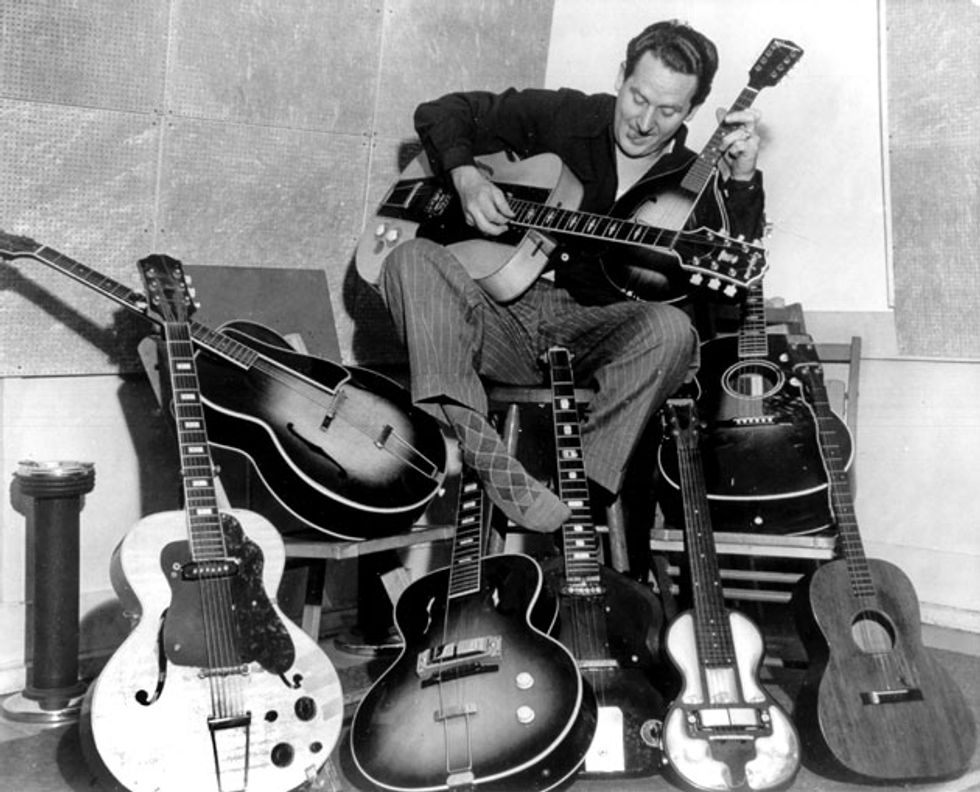

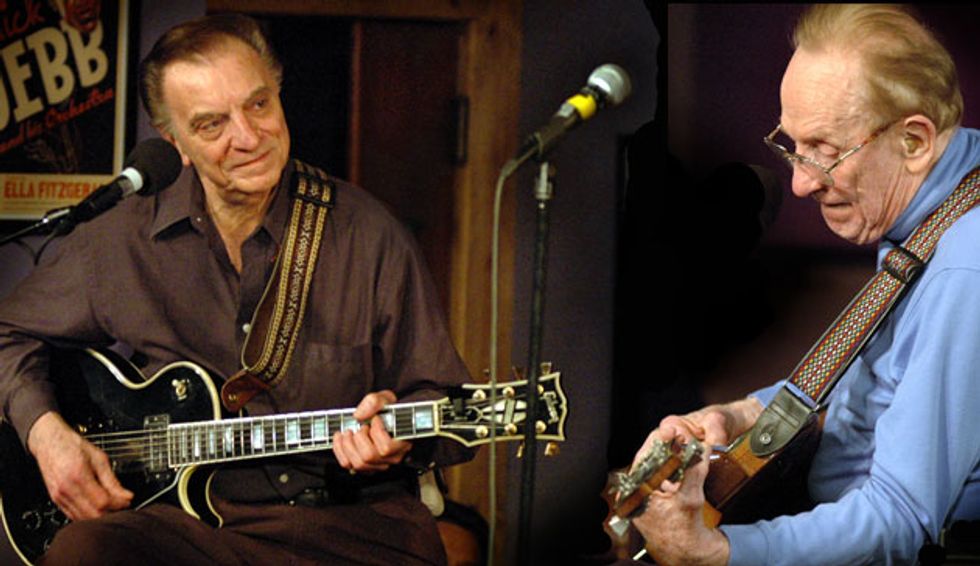
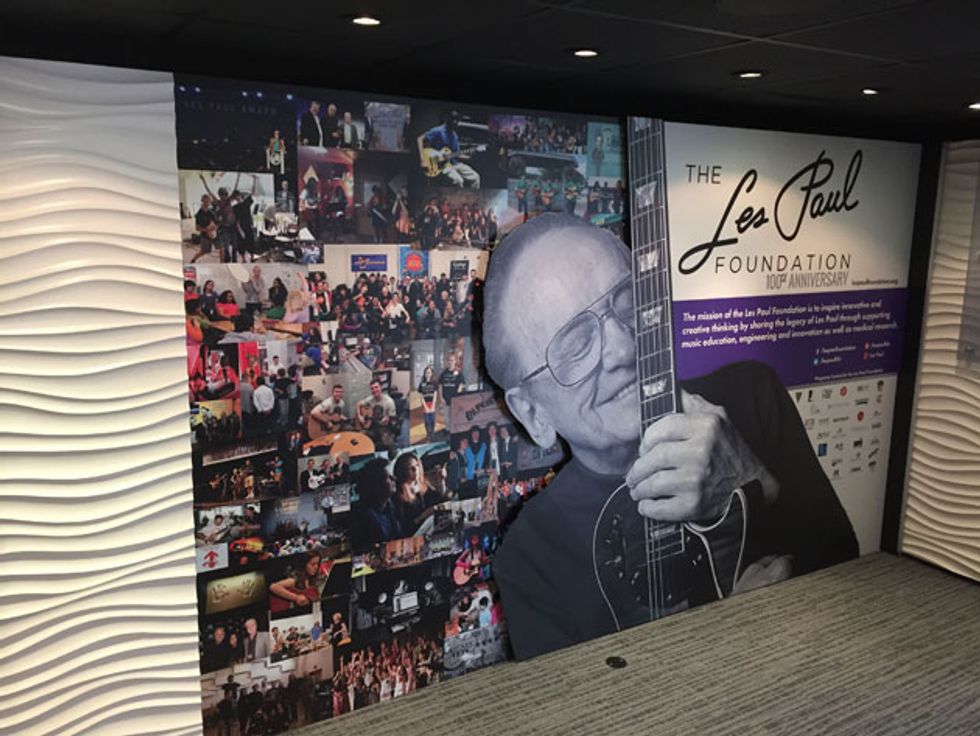
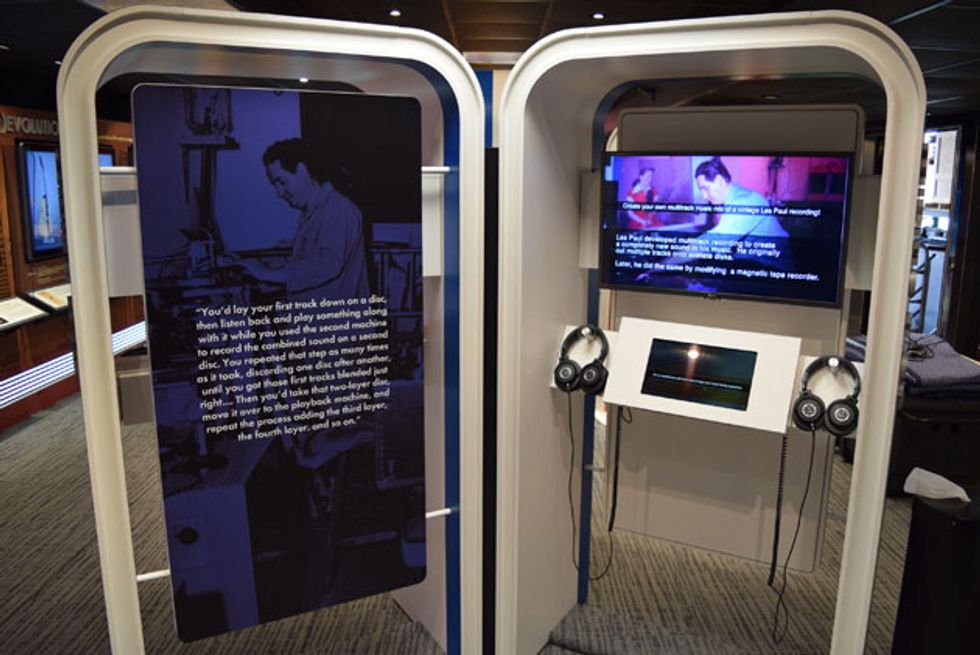
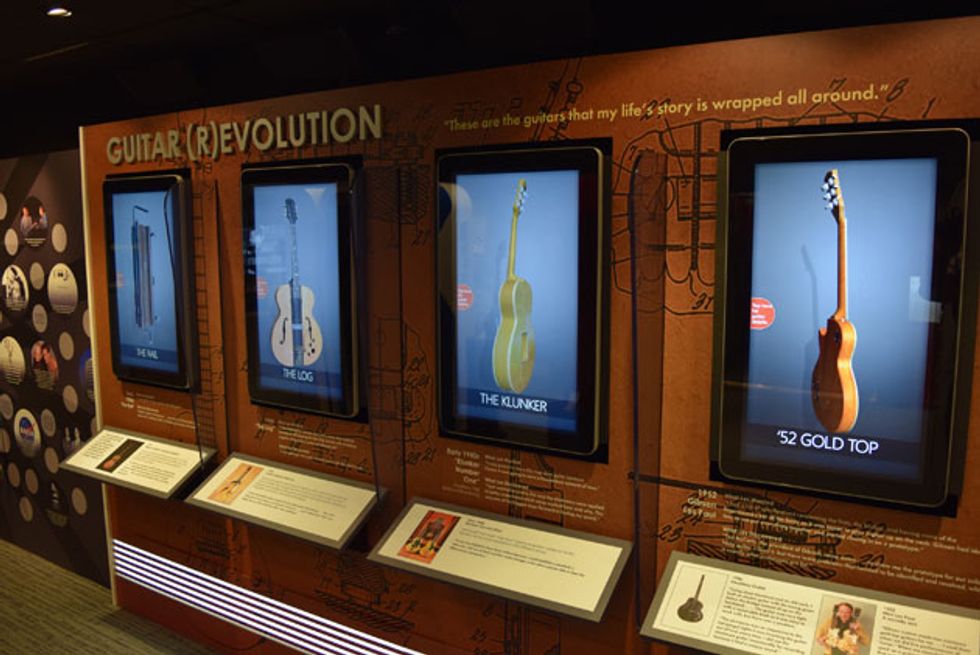
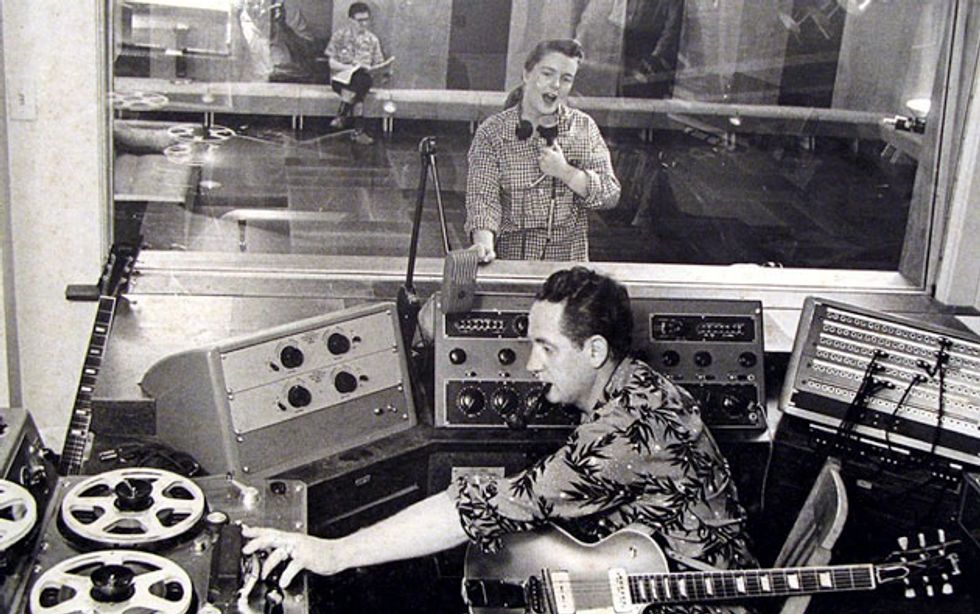





![Devon Eisenbarger [Katy Perry] Rig Rundown](https://www.premierguitar.com/media-library/youtube.jpg?id=61774583&width=1245&height=700&quality=70&coordinates=0%2C0%2C0%2C0)
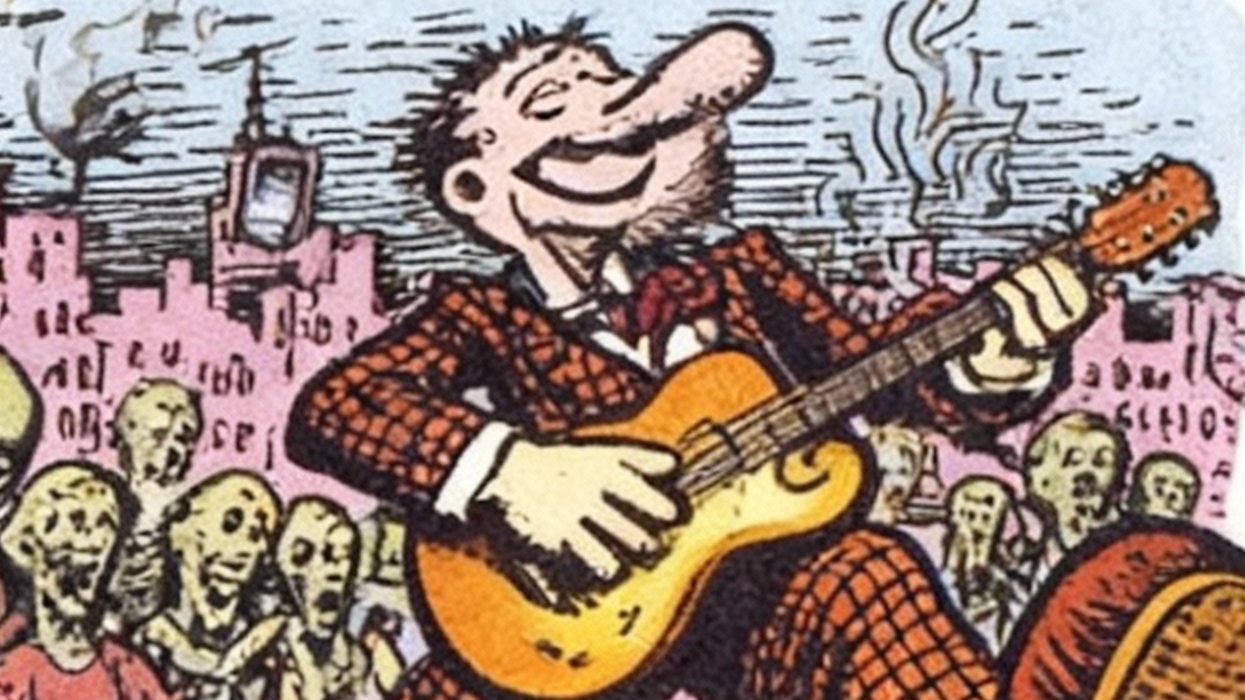












 Zach loves his Sovtek Mig 60 head, which he plays through a cab he built himself at a pipe-organ shop in Denver. Every glue joint is lined with thin leather for maximum air tightness, and it’s stocked with Celestion G12M Greenback speakers.
Zach loves his Sovtek Mig 60 head, which he plays through a cab he built himself at a pipe-organ shop in Denver. Every glue joint is lined with thin leather for maximum air tightness, and it’s stocked with Celestion G12M Greenback speakers.







